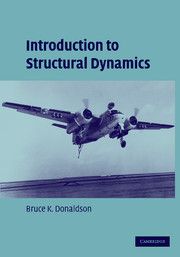Book contents
- Frontmatter
- Contents
- Preface for the Student
- Preface for the Instructor
- Acknowledgments
- List of Symbols
- 1 The Lagrange Equations of Motion
- 2 Mechanical Vibrations: Practice Using the Lagrange Equations
- 3 Review of the Basics of the Finite Element Method for Simple Elements
- 4 FEM Equations of Motion for Elastic Systems
- 5 Damped Structural Systems
- 6 Natural Frequencies and Mode Shapes
- 7 The Modal Transformation
- 8 Continuous Dynamic Models
- 9 Numerical Integration of the Equations of Motion
- Appendix I Answers to Exercises
- Appendix II Fourier Transform Pairs
- Index
- References
8 - Continuous Dynamic Models
Published online by Cambridge University Press: 30 November 2009
- Frontmatter
- Contents
- Preface for the Student
- Preface for the Instructor
- Acknowledgments
- List of Symbols
- 1 The Lagrange Equations of Motion
- 2 Mechanical Vibrations: Practice Using the Lagrange Equations
- 3 Review of the Basics of the Finite Element Method for Simple Elements
- 4 FEM Equations of Motion for Elastic Systems
- 5 Damped Structural Systems
- 6 Natural Frequencies and Mode Shapes
- 7 The Modal Transformation
- 8 Continuous Dynamic Models
- 9 Numerical Integration of the Equations of Motion
- Appendix I Answers to Exercises
- Appendix II Fourier Transform Pairs
- Index
- References
Summary
Introduction
The previous four chapters emphasized the advantages of using discrete mass mathematicaxsl models wherein both the structural mass and the nonstructural mass is “lumped” at selected (usually a relatively few) finite element nodes or at short distances from those finite element nodes. The alternative in mass modeling is the seemingly more realistic mathematical model where the mass is distributed throughout each structural element. Such distributed or continuous mass models are not nearly as useful as discrete mass models. However, continuous mass models do have enough instructional value and occasional engineering value that they cannot be wholly ignored. Their instructional value resides in (i) seeing the results of dealing with what is essentially an infinite DOF system; (ii) the reinforcement, and perhaps deeper understanding, obtained through repetition of the same analysis procedures used with discrete mass systems in a different context; and (iii) discovering the very few types of structures which can be usefully described by this much more concise type of modeling. Therefore the purpose of this chapter is to discuss some of those situations where the use of continuous mass models is of some, albeit small, value in the study of structural dynamics.
Again, continuous mass models are practical only in quite restricted circumstances. All cases examined here are limited to structures that are modeled as a single structural element (e.g., one beam or one plate).
- Type
- Chapter
- Information
- Introduction to Structural Dynamics , pp. 402 - 450Publisher: Cambridge University PressPrint publication year: 2006

